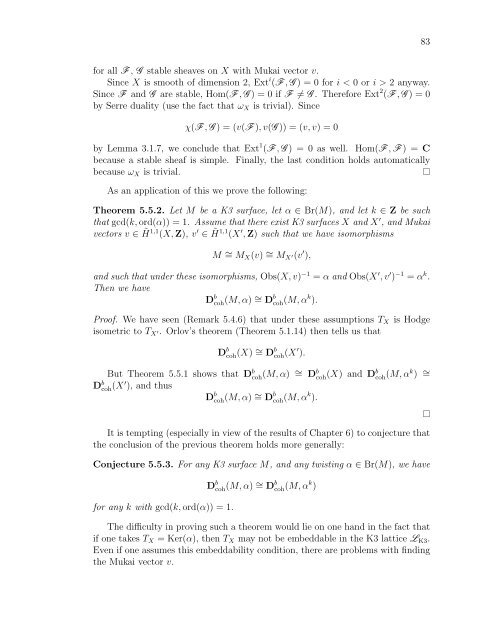derived categories of twisted sheaves on calabi-yau manifolds
derived categories of twisted sheaves on calabi-yau manifolds
derived categories of twisted sheaves on calabi-yau manifolds
Create successful ePaper yourself
Turn your PDF publications into a flip-book with our unique Google optimized e-Paper software.
for all F , G stable <str<strong>on</strong>g>sheaves</str<strong>on</strong>g> <strong>on</strong> X with Mukai vector v.<br />
Since X is smooth <str<strong>on</strong>g>of</str<strong>on</strong>g> dimensi<strong>on</strong> 2, Ext i (F , G ) = 0 for i < 0 or i > 2 anyway.<br />
Since F and G are stable, Hom(F , G ) = 0 if F = G . Therefore Ext 2 (F , G ) = 0<br />
by Serre duality (use the fact that ωX is trivial). Since<br />
χ(F , G ) = (v(F ), v(G )) = (v, v) = 0<br />
by Lemma 3.1.7, we c<strong>on</strong>clude that Ext 1 (F , G ) = 0 as well. Hom(F , F ) = C<br />
because a stable sheaf is simple. Finally, the last c<strong>on</strong>diti<strong>on</strong> holds automatically<br />
because ωX is trivial.<br />
As an applicati<strong>on</strong> <str<strong>on</strong>g>of</str<strong>on</strong>g> this we prove the following:<br />
Theorem 5.5.2. Let M be a K3 surface, let α ∈ Br(M), and let k ∈ Z be such<br />
that gcd(k, ord(α)) = 1. Assume that there exist K3 surfaces X and X ′ , and Mukai<br />
vectors v ∈ ˜ H 1,1 (X, Z), v ′ ∈ ˜ H 1,1 (X ′ , Z) such that we have isomorphisms<br />
M ∼ = MX(v) ∼ = MX ′(v′ ),<br />
and such that under these isomorphisms, Obs(X, v) −1 = α and Obs(X ′ , v ′ ) −1 = α k .<br />
Then we have<br />
D b coh(M, α) ∼ = D b coh(M, α k ).<br />
Pro<str<strong>on</strong>g>of</str<strong>on</strong>g>. We have seen (Remark 5.4.6) that under these assumpti<strong>on</strong>s TX is Hodge<br />
isometric to TX ′. Orlov’s theorem (Theorem 5.1.14) then tells us that<br />
D b coh(X) ∼ = D b coh(X ′ ).<br />
But Theorem 5.5.1 shows that D b coh (M, α) ∼ = D b coh (X) and Db coh (M, αk ) ∼ =<br />
D b coh (X′ ), and thus<br />
D b coh(M, α) ∼ = D b coh(M, α k ).<br />
It is tempting (especially in view <str<strong>on</strong>g>of</str<strong>on</strong>g> the results <str<strong>on</strong>g>of</str<strong>on</strong>g> Chapter 6) to c<strong>on</strong>jecture that<br />
the c<strong>on</strong>clusi<strong>on</strong> <str<strong>on</strong>g>of</str<strong>on</strong>g> the previous theorem holds more generally:<br />
C<strong>on</strong>jecture 5.5.3. For any K3 surface M, and any twisting α ∈ Br(M), we have<br />
for any k with gcd(k, ord(α)) = 1.<br />
D b coh(M, α) ∼ = D b coh(M, α k )<br />
The difficulty in proving such a theorem would lie <strong>on</strong> <strong>on</strong>e hand in the fact that<br />
if <strong>on</strong>e takes TX = Ker(α), then TX may not be embeddable in the K3 lattice LK3.<br />
Even if <strong>on</strong>e assumes this embeddability c<strong>on</strong>diti<strong>on</strong>, there are problems with finding<br />
the Mukai vector v.<br />
83
















